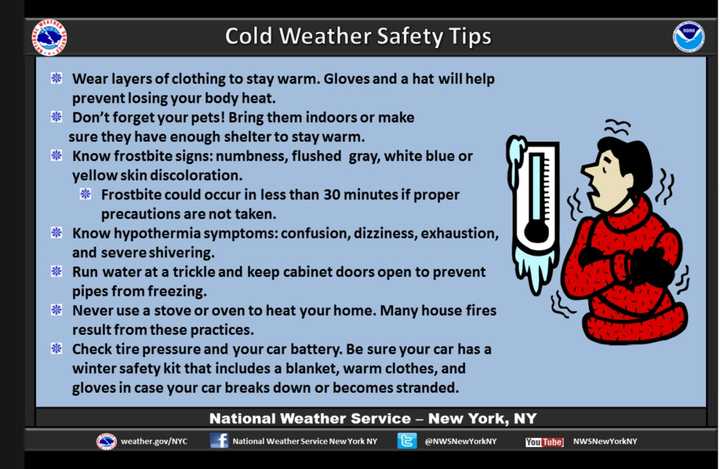“As severe winter weather blankets the state this weekend, I encourage all New Yorkers to stay safe and remain indoors,” Cuomo said in a statement Thursday. “This administration is taking every measure to protect the public safety and as temperatures drop below zero, New Yorkers should exercise caution and avoid all unnecessary travel.”
According to the National Weather Service, a wind-chill watch has been issued for Rockland, Putnam, Orange and parts of Westchester counties that will begin at 6 p.m. Saturday and run through Sunday. Accounting for windchill, low temperatures could feel as low as -25 to -30 degrees.
Urging limited exposure to the outdoors, Cuomo’s office said that such temperatures can cause serious frostbite within as little as 10 minutes.
Temperatures across the state, including counties in New York City and Long Island, are expected to be dangerously low. Parts of upstate and western New York may also experience heavy snowfall, according to the governor’s office.
Cuomo further urged residents to prepare for the weather by stocking emergency supplies in their homes and vehicles. Anyone who must be outside is urged to dress in layers and maintain coverage on the hands and head.
Cuomo’s office supplied a number of safety tips for dealing with the weather:
- FrostbiteTo avoid frostbite, stay inside during severe cold. If you must go out, try to cover every part of your body: ears, nose, toes and fingers, etc. Mittens are better than gloves. Keep your skin dry. Stay out of the wind when possible. Drink plenty of fluids since hydration increases the blood's volume, which helps prevent frostbite. Avoid caffeine, alcohol and cigarettes.
- Degrees of Frostbite
- First degree: ice crystals forming on your skin
- Second degree: Skin begins to feel warm, even though it is not yet defrosted.
- Third degree: Skin turns red, pale or white.
- Fourth degree: Pain lasts for more than a few hours and skin may develop dark blue or black. See a doctor immediately if these symptoms arise. Gangrene is a real threat.
- First Aid - Until You Can Get Indoors
- Don't rub or massage cold body parts.
- Put your hands in your armpits.
- Hold onto another person or animal.
- Drink warm liquids.
- Put on extra layers of clothes, blankets, etc.
- Remove rings, watches and anything tight.
- First Aid - Once Indoors
- Don't walk on a frostbitten foot. You could cause more damage.
- Get in a warm, NOT hot, bath and wrap your face and ears in a moist, warm, NOT hot, towel.
- Don't get near a hot stove or heater or use a heating pad, hot water bottle or a hair dryer. You may burn yourself before feeling returns.
- Frostbitten skin will become red and swollen and feel like it's on fire. You may develop blisters. Don't break the blisters. It could cause scarring.
- If your skin turns blue or gray, is very swollen, blistered or feels hard and numb even under the surface, go to a hospital immediately.
- Hypothermia: is caused by prolonged exposure to cold temperatures, especially in children and the elderly. Watch for the following symptoms: inability to concentrate, poor coordination, slurred speech, drowsiness, exhaustion, and/or uncontrollable shivering, following by a sudden lack of shivering. If a person’s body temperature drops below 95 degrees Fahrenheit, get emergency medical assistance immediately. Remove wet clothing, wrap the victim in warm blankets, and give warm, non-alcoholic, non-caffeinated liquids until help arrives.
- Frozen Pipes: Prevent pipes from freezing by turning on both hot and cold water faucets slightly, preferably in a basement sink – running water will not freeze as quickly. Open cabinet doors to allow more heat to get to non-insulated pipes under a sink or appliance near an outer wall. If you plan to leave your residence, drain and shut off the water system (except indoor sprinkler systems).If your pipes burst, make sure you and your family knows how to shut off the water. Stopping water flow minimizes damage to your home. Call a plumber and contact your insurance agent. Never try to thaw a pipe with an open flame or torch. Always be careful of the potential for electric shock in and around standing water.
Visit www.governor.ny.gov for for a full list of precautionary measures.
Click here to follow Daily Voice Armonk and receive free news updates.

